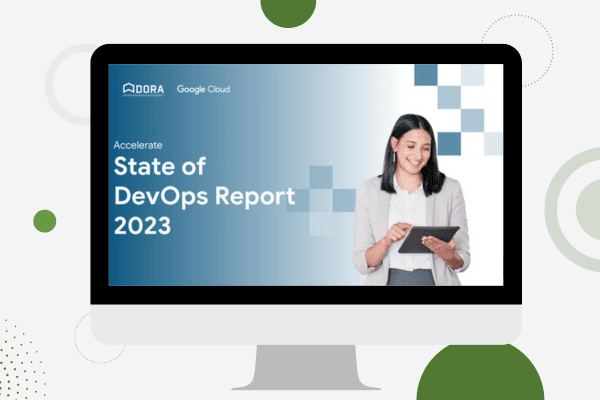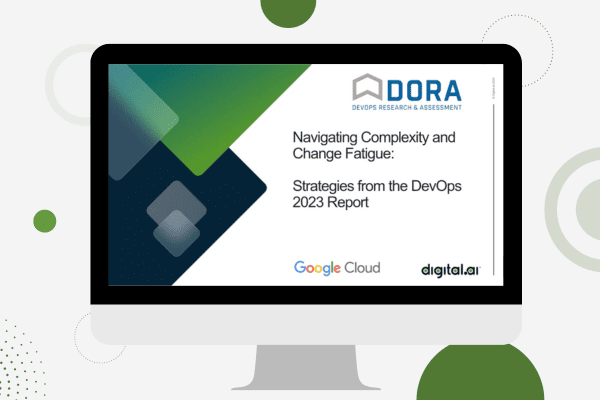Defining DORA Metrics
Unlock DevOps efficiency with DORA metrics (Deployment Frequency, Lead Time, etc.). Learn how they impact performance & implement with tools & solutions.
In DevOps, metrics play a pivotal role in assessing performance and guiding improvement efforts. Among the most renowned sets of metrics are DORA (DevOps Research and Assessment) metrics. These metrics provide invaluable insights into the efficiency and effectiveness of DevOps practices within an organization.
The Importance of DORA Metrics
DORA metrics serve as a compass for organizations navigating the complex landscape of software development and deployment. By quantifying key aspects of the development process, they offer clarity and direction, enabling teams to make informed decisions and drive continuous improvement initiatives.
Detailed Understanding of DORA Metrics
Founded by the DevOps Research and Assessment (DORA) team, the program’s goal was to understand the practices, processes, and capabilities enable teams to achieve high performance in software and value delivery. DORA is the largest and longest running research program of its kind and helps teams apply those capabilities, leading to better organizational performance. The four core DORA metrics are:
Deployment Frequency:
How often does your organization deploy code to production or release it to end users?
Deployment frequency measures how often a team pushes changes to production. High deployment frequency indicates rapid iteration and delivery, a hallmark of agile and DevOps methodologies.
Lead Time for Changes:
How long does it take to go from code committed to code successfully running in production?
Lead time for changes measures the total time between when work on a change request is initiated to when that change has been deployed to production and thus delivered to the customer. Short lead times signify streamlined processes and efficient workflows, facilitating faster time-to-market.
Time to Restore Services:
How long does it generally take to restore service when a service incident or a defect that impacts users occurs?
Time to restore services reflects the speed of the time from an incident having been triggered to the time when it has been resolved via a production change, measuring the speed at which teams can recover from incidents or outages. Minimizing this metric is crucial for maintaining high availability and ensuring a positive user experience.
Change Failure Rate:
What percentage of changes to production or released to users result in degraded service and subsequently require remediation?
Change failure rate measures the rate at which production changes result in incidents, rollbacks, or failures. It quantifies the percentage of changes that result in service degradation or disruptions. Low change failure rates indicate robust testing procedures and reliable deployment practices.
The Impact of DORA Metrics on Software Development
DORA metrics profoundly influence software development by driving performance improvements and fostering a culture of continuous enhancement. Leveraging these metrics allows teams to identify bottlenecks, optimize processes, and prioritize initiatives, resulting in faster time-to-market, higher-quality releases, and improved customer satisfaction. Ultimately, the integration of DORA metrics into software development practices empowers organizations to achieve greater efficiency, agility, and innovation, driving tangible business outcomes.
Improving Performance Through DORA
Where is the data coming from? Where lead time, time to restore services, and change failure rate are all obtained from Service Management tools or any other kind of agile planning tool, deployment frequency comes from a deploy tool (like Digital.ai Deploy) or from a CI integration tool like Jenkins.
The DORA metrics are used to rank a software team’s performance, either high or low, as it pertains to software development and delivery capabilities. By focusing on DORA metrics, organizations can identify bottlenecks, optimize processes, and foster a culture of continuous improvement. This leads to enhanced productivity, higher quality releases, and greater customer satisfaction. In the end, these metrics give your teams the capabilities to improve where they are today; it’s your baseline and allows you to form your desired future goals from there.
DORA Metrics and DevOps
DORA metrics and DevOps are symbiotic, with DORA serving as a cornerstone for measuring and enhancing DevOps performance. Aligned with DevOps principles, DORA metrics drive continuous improvement by offering objective benchmarks for evaluating processes like deployment frequency and lead time for changes. They enable data-driven decision-making, foster collaboration, and support continuous feedback loops, all essential elements of DevOps culture. In essence, DORA metrics empower organizations to optimize their DevOps practices, innovate more effectively, and achieve meaningful business outcomes.
How to Implement DORA Metrics
Implementing DORA metrics requires a strategic approach involving tool selection, data collection, and cultural alignment. Organizations should invest in tools that facilitate tracking and analyzing DORA metrics seamlessly. Overall, a holistic approach encompassing tools, data practices, and cultural alignment is key to implementing DORA metrics effectively.
Tools for Tracking DORA Metrics
Effectively tracking DORA metrics requires reliable tools and solutions that provide actionable insights and support continuous improvement. Here are some key features to look for in a DORA metrics tool:
- Advanced Analytics Capabilities: A good DORA metrics tool should offer advanced analytics capabilities to help organizations identify bottlenecks and optimize their application delivery process. Look for features such as real-time visibility into key metrics like deployment frequency, lead time for changes, time to restore services, and change failure rate.
- Proactive Value Delivery: The ideal DORA metrics tool enables organizations to proactively deliver value by identifying changes that may impact the business. It should provide data-driven insights to support decision-making and help teams avoid software change failure.
- Risk Mitigation and Issue Resolution: A reliable DORA metrics tool should assist in mitigating risks by promptly identifying and resolving issues during the software delivery process. It should offer insights into the root causes of failures and performance bottlenecks, empowering teams to take proactive measures to improve reliability.
- Integration and Scalability: Look for a DORA metrics tool that seamlessly integrates with existing DevOps tools and workflows. It should be compatible with popular CI/CD platforms, version control systems, and monitoring tools, allowing for easy aggregation and analysis of data from across the pipeline. Additionally, scalability is essential to accommodate the evolving needs of your organization as it grows.
- Actionable Insights for Continuous Improvement: Choose a DORA metrics tool that provides actionable insights to drive continuous improvement. It should offer recommendations for optimizing release cadence, streamlining testing processes, and enhancing collaboration between development and operations teams.
Challenges and Solutions in Implementing DORA Metrics
Implementing DORA metrics can be a transformative journey for organizations, but it’s not without its challenges. Here we explore some common obstacles and effective solutions:
Data Collection
Challenge: One of the primary challenges in implementing DORA metrics is ensuring consistent and reliable data collection. Organizations must establish robust monitoring systems and instrumentation practices to capture relevant metrics effectively.
Solution: Organizations should invest in comprehensive monitoring and observability solutions. By leveraging tools such as application performance monitoring (APM) systems, log management platforms, and infrastructure monitoring tools, teams can gather real-time data from across the software delivery pipeline. Additionally, implementing standardized instrumentation practices and integrating data from various sources into a centralized repository can improve data quality and accessibility.
Adoption and Culture Change
Challenge: Adopting DORA metrics requires more than just technological solutions—it necessitates a cultural shift within the organization. Resistance to change, lack of buy-in from stakeholders, and existing cultural norms centered around blame rather than learning can impede the adoption of metrics-driven practices.
Solution: Overcoming cultural barriers requires strong leadership, effective communication, and a focus on collaboration and continuous learning. Leaders must articulate the benefits of DORA metrics and align them with broader business objectives. They should foster a culture of psychological safety where team members feel empowered to experiment, fail, and learn from their experiences. Encouraging transparency and accountability at all levels of the organization can also promote adoption and engagement with DORA metrics. Additionally, providing training and resources to support teams in understanding and leveraging metrics effectively can facilitate cultural change. Overall, a healthy culture has a positive impact on all key outcomes, especially the new performance metric from the 2023 Accelerate State of DevOps Report: team performance.
Maturity of Your DevOps Team
Challenge: The maturity level of the DevOps team can impact the successful implementation and utilization of DORA metrics. Teams with varying levels of experience and understanding of DevOps principles may struggle to interpret and act upon metric data effectively.
Solution: Organizations should prioritize training and skill development programs to enhance the proficiency of their DevOps teams. Providing access to resources such as workshops, certifications, and mentorship opportunities can help team members develop a deeper understanding of DevOps practices and principles. Additionally, fostering a culture of continuous learning and improvement can encourage team members to embrace DORA metrics as a tool for driving excellence in software delivery.
Tooling and Technology Integration
Challenge: Selecting and integrating the right tools and technologies to track and analyze DORA metrics can be challenging. Organizations may face compatibility issues, scalability concerns, and complexities associated with integrating disparate systems and data sources.
Solution: Organizations should conduct a thorough assessment of their existing tooling landscape and identify gaps and redundancies. Investing in integrated DevOps platforms that offer built-in support for DORA metrics can streamline implementation and reduce complexity. Additionally, leveraging open-source solutions and APIs to enable interoperability between tools and systems can enhance flexibility and scalability. Collaborating with vendors and industry partners to develop standardized interfaces and integrations can also simplify tooling and technology integration efforts.




